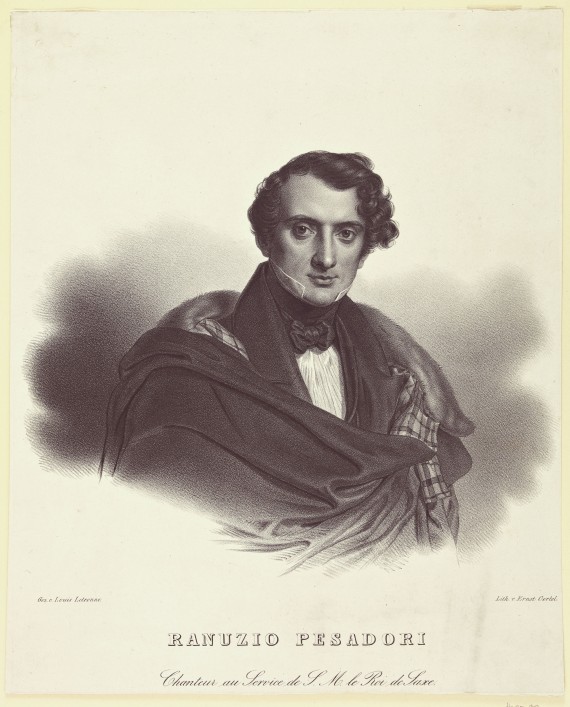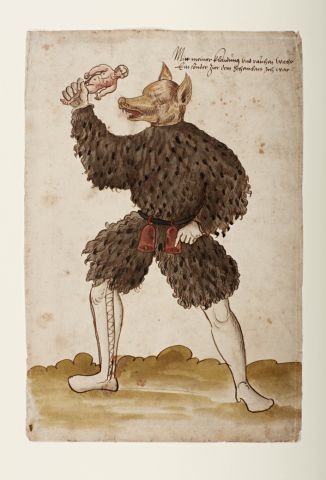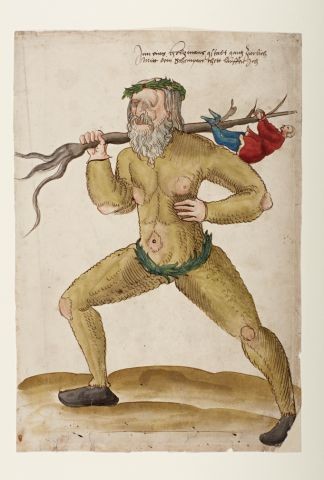Restitutions
 Lithographie von Ernst Oertel, Porträt des Tenors Ranunzio Pesadori, 1.H. 19. Jh.
Lithographie von Ernst Oertel, Porträt des Tenors Ranunzio Pesadori, 1.H. 19. Jh.
©Deutsches Theatermuseum
2014: Successful restitution of a charcoal drawing by Louis Letronne (Portrait of Ranunzio Pesadori) as well as a lithograph by Ernst Oertel, after Louis Letronne’s portrait, from the collection of Michael Berolzheimer
Dr. Michael Berolzheimer died on 5 June 1942 in Mount Vernon, New York. In 2012 the Holocaust Claims Processing Office (HCPO), commissioned by his heirs with the restitution of the art collection, first approached the Österreichisches Theatermuseum (Austrian Theatre Museum), as it was believed it housed an original drawing by Louis Letronne (1790–1842) that was being sought. As the museum in Vienna did not own such a sheet, the enquiry was passed on to the Deutsches Theatermuseum. Subsequent research revealed that two sheets, both the charcoal drawing by Louis Letronne and the lithograph by Ernst Oertel made after it, were purchased in 1939 at the Weinmüller auction house in Munich. This could also be proven in the holdings. Both the drawing and the lithograph are portraits of the tenor Ranunzio Pesadori (1800–1871) in civilian dress.
In Munich, the lawyer Dr. Michael Berolzheimer (1866–1942) used his extensive knowledge of art in his function as a member of the buying committee at the Alte Pinakothek, the Graphische Sammlung (Prints Collection) and the Deutsche Orientgesellschaft (German Oriental Society), among others. As a private person, Berolzheimer built up an impressive collection of works of art from around 1895 onwards. Under pressure from the Nazi regime Dr. Michael Berolzheimer and his wife sought permission to emigrate in 1938 that was only granted upon relinquishing part of their property and assets. That same year they emigrated to New York. Subsequently Berolzheimer received demands from the German authorities for the payment of a ‘Judenvermögensabgabe’ (tax on Jewish assets) and his German citizenship was withdrawn.
Some 800 works from the Berolzheimer collection were included in sales at the art auctioneers Adolf Weinmüller on 1/2 December 1938 and on 9/10 March 1939 in Munich. As documented in the Weinmüller catalogue, the auction lots also included a charcoal portrait of the singer Ranunzio Pesadori by Louis Letronne. The drawing was listed as lot no. 732 in the catalogue and was offered together with a lithograph by Ernst Oertel (after an original by Letronne). After a close examination of the restitution claim by the Provenance Research Department at the Bayerische Staatsgemäldesammlungen and the museums’ legal department, and in recognition of the principles to identify and restitute works of art and cultural assets seized during the Nazi era by unjust means (Washington Declaration), to which the Free State of Bavaria and its institutions are bound, the Deutsches Theatermuseum was able to restitute the two works on paper mentioned above on 25.06.2014 to the heirs of Dr. Michael Berolzheimer.
 Figurine zum Nürnberger Schembartlauf, 17. Jh.
Figurine zum Nürnberger Schembartlauf, 17. Jh.
©Deutsches Theatermuseum
Provenance research on 7 original drawings from the Siegfried Lämmle Collection suspected as being looted works of art
Following the find of annotated auction catalogues from the Helbing / Weinmüller auctioneers that were then presented to the Zentralinstitut für Kunstgeschichte in Munich in 2013 and their subsequent evaluation, the suspicion surrounding the provenance of 7 original drawings from the holdings of prints and drawings at the Deutsches Theatermuseum could be substantiated. From notes written in a catalogue for the auction on 09/10.03.1939, the person who consigned the works, the Munich art and antiques dealer Siegfried Lämmle, as well as the purchaser, the Theatermuseum, are clearly recorded. The 7 drawings came from the private collection of Siegfried Lämmle or the holdings of the art dealer’s business that had not been sold. Following the decree passed by the president of the Reichskammer der Bildenden Künste (Reich Reich Chamber of Fine Arts) on 28.08.1935, Jewish art dealers were subsequently barred from the chamber in Munich and forbidden from executing their profession from then on. As a reaction to this development, Siegfried and his son Walter Lämmle, who was intended to take over the company, started with the dispersal of artworks and antiques in their business from September 1936 onwards. Once the art dealer’s company had completely ceased operating in February 1938, Siegfried Lämmle and his wife Betty submitted an application to emigrate. After they were instructed to have those works of art valued by the authorities that were in their private possession and that were to have been exported to America, an evaluation of the same was carried out by a member of staff at Weinmüller auction house. At the end of September 1938 Siegfried and Betty Lämmle were able to emigrate to the USA via France. Prior to their departure the couple had their furniture and personal effects, including the private art collection that had been valued, stored at a removal company in Munich in preparation for their shipment to America. At the end of November 1938 all works of art in storage were confiscated by the Gestapo and subsequently sold.
 Figurine zum Nürnberger Schembartlauf, 17. Jh.
Figurine zum Nürnberger Schembartlauf, 17. Jh.
©Deutsches Theatermuseum
The 7 original drawings from the holdings of the Deutsches Theatermuseum, comprising 5 figurines from the Nuremberg ‘Schembartlauf’ (17th century) and 2 depictions of guild dances (18th century), formed part of this sale and were auctioned on 09/10.03.1939.
A few months after his wife Betty died at the age of 68 on 12 August 1948 in Los Angeles, Siegfried Lämmle and his son Walter submitted a claim for compensation within the time frame stipulated, on 21 December 1948, to the central claims office in Bad Nauheim. Five years after his wife’s death, Siegfried Lämmle died on 11 June 1953, in Los Angeles, at the age of 90. His youngest son Walter was the executor of the will. The compensation process between Walter Lämmle and the Federal Republic of Germany lasted several years. A settlement was reached in 1958. This consisted in the main of a compensation payment that covered those works of art from the private art collection of Siegfried Lämmle which could not be found at that time. The sheets identified as formerly having been in the possession of Siegfried Lämmle and now in the Theatermuseum are, according to records and as a result of the settlement agreed and the compensation payment made, the legitmate property of the Deutsches Theatermuseum.
In January 2017 the Deutsches Theatermuseum informed the heirs of Siegfried Lämmle of their endeavours and the results of the provenance research carried out. The Deutsches Theatermuseum expressly regrets the circumstances that came to light and the events that led to the sale of the works of art.
